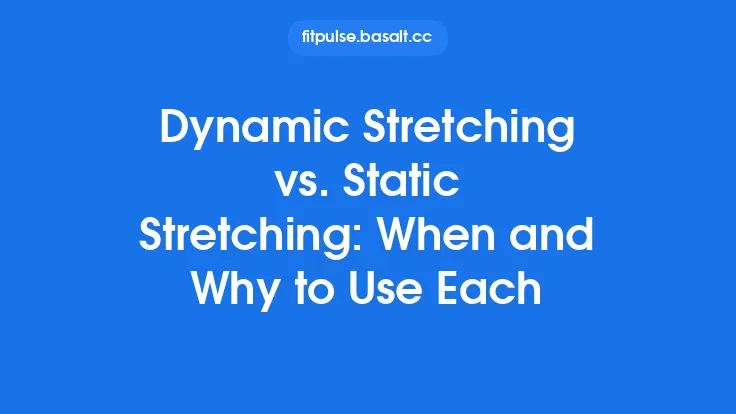Static stretching has been a staple of fitness routines for decades, yet it remains shrouded in misconceptions that can influence how athletes, clinicians, and casual exercisers approach their training. These myths often stem from outdated research, anecdotal observations, or a simple misunderstanding of the underlying physiology. By dissecting the most prevalent myths and grounding the discussion in current scientific evidence, we can develop a clearer, more nuanced view of static stretching’s role in flexibility, performance, and overall musculoskeletal health.
Myth 1 – “Static Stretching Significantly Reduces Strength and Power”
The claim: Many coaches and athletes avoid static stretching before high‑intensity activities because they believe it leads to a measurable loss in force production.
The reality: Acute reductions in maximal voluntary contraction (MVC) have been observed in some laboratory settings, but the effect size is modest (typically 2–5 % of peak torque) and highly dependent on the stretch duration, intensity, and the muscle group involved. Moreover, the decrement is transient, often dissipating within 5–10 minutes after the stretch. In real‑world scenarios—where warm‑up protocols include a combination of low‑intensity aerobic activity, dynamic movements, and sport‑specific drills—the impact of a brief static stretch is negligible.
Why the myth persists: Early studies used prolonged (≥60 seconds) static holds on isolated muscle groups, which do not reflect typical pre‑competition routines. Media headlines amplified these findings without contextualizing the magnitude or duration of the effect.
Takeaway: A short static stretch (≤30 seconds) performed as part of a comprehensive warm‑up is unlikely to impair strength or power. The key is to balance static stretching with dynamic activation to maintain neuromuscular readiness.
Myth 2 – “Static Stretching Before Exercise Increases Injury Risk”
The claim: Static stretching is often blamed for a higher incidence of strains, sprains, or other musculoskeletal injuries when performed before activity.
The reality: Systematic reviews of prospective cohort studies and randomized controlled trials have found no consistent link between pre‑activity static stretching and injury rates. In fact, when static stretching is combined with an appropriate warm‑up, it can improve joint range of motion (ROM) without compromising tissue integrity. Injuries are more strongly associated with factors such as fatigue, inadequate conditioning, and sudden, uncontrolled movements rather than the presence of a static stretch.
Why the myth persists: Anecdotal reports of injuries occurring after a static stretch are often misattributed, overlooking other contributing variables (e.g., insufficient warm‑up, poor technique, or pre‑existing imbalances). Additionally, early research on static stretching in isolation (without a preceding aerobic or dynamic component) suggested a temporary reduction in muscle stiffness, which was mistakenly interpreted as a “softening” that predisposes tissue to damage.
Takeaway: Static stretching alone does not increase injury risk; it is the overall quality of the warm‑up and the athlete’s preparedness that matters most.
Myth 3 – “Static Stretching Is Only About Increasing Flexibility”
The claim: The sole purpose of static stretching is to lengthen muscles and improve joint ROM.
The reality: While increasing ROM is a primary outcome, static stretching also influences several other physiological processes:
- Neural adaptations: Prolonged holds can modulate the stretch reflex, reducing excessive muscle activation and allowing smoother movement patterns.
- Viscoelastic changes: Time‑dependent stress relaxation of connective tissue can improve the compliance of tendons and fascia, facilitating more efficient force transmission.
- Psychological benefits: The deliberate, controlled nature of static stretching can promote relaxation, body awareness, and a sense of readiness, which are valuable for performance and recovery.
Why the myth persists: Traditional flexibility programs often emphasize “touch‑the‑toes” goals, reinforcing the notion that flexibility is the only metric of success. This narrow focus overlooks the broader neuromuscular and psychosomatic contributions of static stretching.
Takeaway: Static stretching serves multiple functions beyond flexibility, including neural regulation, tissue compliance, and mental preparation.
Myth 4 – “You Must Hold a Stretch Until You Feel Pain to Gain Benefits”
The claim: The deeper the stretch (i.e., the more discomfort you feel), the greater the gains in flexibility and performance.
The reality: Stretch intensity should be calibrated to a point of mild tension, often described as a “stretch sensation” rather than sharp pain. Exceeding this threshold can trigger protective mechanisms, such as increased muscle spindle activity, leading to reflexive contraction (the stretch reflex) that opposes further lengthening. Moreover, excessive discomfort can cause micro‑trauma to the muscle‑tendon unit, potentially delaying adaptation.
Why the myth persists: The “no pain, no gain” mentality pervades many fitness cultures, and the subjective nature of stretch discomfort makes it easy to misinterpret normal tension as a necessary indicator of progress.
Takeaway: Aim for a comfortable stretch that elicits a gentle pull; this is sufficient to stimulate the desired physiological responses without risking injury or counterproductive reflexes.
Myth 5 – “Static Stretching Is Unnecessary If You Move Enough Throughout the Day”
The claim: Daily functional movement (walking, standing, light activity) eliminates the need for dedicated static stretching sessions.
The reality: While regular movement maintains baseline joint health, static stretching provides a targeted, controlled stimulus that everyday activities cannot guarantee. Functional movement often occurs within a limited ROM dictated by habitual postures and task demands. Static stretching deliberately challenges the end range of a joint, encouraging adaptations that expand that range beyond everyday use.
Why the myth persists: The rise of “active lifestyle” narratives suggests that any movement is beneficial, leading some to assume that structured stretching is redundant.
Takeaway: Even active individuals benefit from intentional static stretching to address specific ROM limitations and to maintain balanced musculoskeletal function.
Myth 6 – “Static Stretching Is Only for Older Adults or Those with Low Fitness Levels”
The claim: Younger, high‑performance athletes do not need static stretching because they are already flexible.
The reality: Flexibility is highly individual and not solely age‑dependent. Elite athletes in sports requiring explosive power (e.g., sprinting, weightlifting) often possess a narrower ROM in certain joints, which can be a performance limiter or injury risk factor. Targeted static stretching can help these athletes achieve optimal joint angles for force production while preserving muscular tension needed for power output.
Why the myth persists: Observationally, many older adults engage in static stretching as part of mobility programs, reinforcing the stereotype that it is a “senior” activity.
Takeaway: Static stretching is a valuable tool across the lifespan, including for high‑performance athletes who require precise ROM control.
Myth 7 – “Static Stretching Can Replace Strength Training”
The claim: Because static stretching improves muscle length, it can serve as a substitute for resistance work.
The reality: Stretching and strength training elicit fundamentally different adaptations. Static stretching primarily influences the passive components of the musculoskeletal system (e.g., connective tissue compliance) and neural regulation of muscle tone. Strength training, conversely, induces hypertrophy, neural drive enhancements, and improvements in contractile force. While both modalities can coexist synergistically, one cannot fully compensate for the other’s unique benefits.
Why the myth persists: Some rehabilitation protocols emphasize flexibility as a primary goal, leading patients to believe that once flexibility is achieved, further training is unnecessary.
Takeaway: Incorporate both static stretching and strength training to achieve a balanced, functional musculoskeletal profile.
Myth 8 – “All Static Stretches Are Created Equal”
The claim: Any static stretch performed for a given duration will produce the same effect regardless of joint angle, muscle length, or body position.
The reality: The mechanical and neural responses to a static stretch are highly dependent on the specific joint configuration and the portion of the muscle‑tendon unit being targeted. For example, a hamstring stretch performed with the hip flexed versus extended places different amounts of strain on the proximal versus distal fibers, leading to distinct adaptations. Additionally, the presence of antagonistic muscle activation (co‑contraction) can modulate the stretch’s effectiveness.
Why the myth persists: Simplified “one‑size‑fits‑all” stretching routines are popular in group fitness settings, where individualized adjustments are logistically challenging.
Takeaway: Tailor static stretches to the anatomical and functional context of the target muscle group for optimal outcomes.
Myth 9 – “Static Stretching Has No Place in Modern Athletic Training”
The claim: Contemporary training philosophies favor dynamic, ballistic, or proprioceptive neuromuscular facilitation (PNF) techniques, rendering static stretching obsolete.
The reality: While dynamic and PNF methods are valuable, static stretching still occupies a unique niche. Its low‑equipment, low‑intensity nature makes it ideal for:
- Post‑session cool‑downs where the goal is to promote relaxation and restore baseline muscle length.
- Pre‑rehabilitation phases where controlled, low‑load stretching can safely improve ROM without stressing healing tissues.
- Situations requiring precise joint positioning (e.g., yoga, martial arts) where static holds are integral to skill execution.
Why the myth persists: Marketing of newer modalities often emphasizes novelty, inadvertently casting older methods as outdated.
Takeaway: Static stretching remains a relevant, evidence‑based component of a comprehensive training toolbox.
Myth 10 – “Static Stretching Is Ineffective Because Flexibility Gains Plateau Quickly”
The claim: After a few weeks of static stretching, further improvements cease, making the practice a waste of time.
The reality: Initial gains in ROM are indeed rapid, largely due to neural adaptations (e.g., reduced stretch reflex sensitivity). Subsequent improvements occur at a slower rate, reflecting structural changes in connective tissue. However, continued static stretching can still yield incremental benefits, especially when combined with progressive overload principles (e.g., increasing stretch intensity, varying joint angles). Moreover, maintaining flexibility is as important as gaining it; regular static stretching prevents regression.
Why the myth persists: Early enthusiasm can be dampened by the slower pace of later-stage progress, leading some to abandon the practice prematurely.
Takeaway: Persistence pays off—steady, long‑term static stretching maintains and modestly enhances flexibility beyond the initial plateau.
Integrating the Truth: Practical Guidelines for the Skeptical Practitioner
- Contextualize the Stretch – Use static stretching as part of a balanced warm‑up or cool‑down, not as the sole preparatory activity.
- Control Intensity – Aim for a mild stretch sensation; avoid sharp pain or excessive discomfort.
- Mind the Duration – Short to moderate holds (15–30 seconds) are sufficient for most goals; longer holds are reserved for specific therapeutic aims.
- Individualize the Position – Adjust joint angles to target the desired portion of the muscle‑tendon unit.
- Combine with Complementary Modalities – Pair static stretches with dynamic movements, strength work, and proprioceptive drills for a holistic program.
- Monitor Adaptations – Track ROM, perceived effort, and performance metrics to ensure the stretching regimen is delivering the intended benefits.
- Educate Stakeholders – Communicate the evidence behind static stretching to athletes, coaches, and patients to dispel lingering myths.
By confronting these misconceptions with data‑driven explanations, we empower fitness professionals and enthusiasts to make informed decisions about when and how to incorporate static stretching into their routines. The result is a more nuanced, effective approach that respects both the science and the individual needs of each practitioner.





